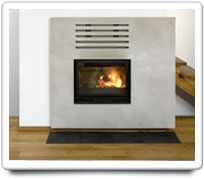Question Topic
Fireplace (Gas) Location Question

Home-Wizard™ calculates your ideal home care program to avoid problems with your Fireplace (gas), but sometimes trouble can still occur. Here are answers to questions about fireplace (gas) location question.
QUESTION FROM CHRIS
I have had a Thelin Co. Parlour Direct Vent Gas Stove for about 5 years that is DV wall-vented (outside tube supplies fresh air & inside tube is for exiting gas); where, I will have the active flame & pilot GO OUT during the high and FREQUENT mountain wind gusts here in Breckenridge, CO (80424) at an altitude of 9800'. This is a 'pot-belly' stove that vents out the top 3' vertically w/ a 1' horizontal pipe to the outside wall w/ a square horizontal cap. The stove is in the basement, so a vertical rise to roof height (1 & 1/2 stories) is not possible. During high winds, I can observe the flame getting 'larger' w/ high wind gusts, then getting smaller as wind ceases, w/ the flame finally blowing out w/ continued high wind gusts. If I open the front (flame/pilot are OUT, stove is "OFF" & stove has vented gas) during these gusty times, you can feel significant cold air coming in the house from the outside w/ sufficient force to prevent a 'manual' lighting of the pilot (matches will be actually be 'blown out'). I usually use the 'pilot starter', just so you know.
Additionally, if I place the stove in 'pilot only' mode (not "ON"), the pilot will most always stay lit during high winds (but not always): The stove has an auto-gas shutdown feature when the pilot goes out (you hear a 'click' when the gas service is terminated). When this flame blow out occurs, we smell gas for a brief period - I believe there is so much wind coming into the stove from the outside that it is pushing the residual gas into the home following blow-out of the flame.
I'm wondering if the Air Shutter in the documentation needs adjustment by a service technician?
I noticed on Simpson's DuraVent web site that they now supply a 'high wind' horizontal cap, but I'm wondering if this will be sufficient to solve the problem?
http://www.duravent.com/pdf/dvp_caps2007.pdf
Otherwise, how can I have a service tech mitigate winds continually blowing out the flame?
I can be reached via email or my CELL (number removed for security reasons).
THX for your assistance here
ANSWER FROM HOME-WIZARD
Dear Chris:
First, I want to thank you for sending in such a detailed explanation of your problem. I wish that everyone who submitted questions took the time that you have to thoroughly describe their situation. It really helps us to understand what your specific problem is, and how we can best assist you in resolving it.
Second, your instincts are correct, and yes, we would strongly recommend that you bring in a trained service technician who can physically examine your gas fireplace and how it is located in your house, and who can make the necessary changes to stop the problems that you are having from high winds.
The reason I suggest that you have someone who can physically see your situation, is that there a three challenging situations with locating gas fireplaces:
1) High altitudes.
2) Basement locations.
3) High winds.
. . . and you have all three of these challenges together!
For example, regarding you being at a high altitude, some direct vent gas fireplaces require that when installing the unit at an elevation above 2000 feet that it may be necessary to decrease the input rating by changing the existing burner orifice to a smaller size. And for these, the input should be reduced 4 percent for each 1000 feet above sea level. However, if the heating value of the gas has been reduced, this general rule may not apply. But regardless, it is always best to check with local authorities for assistance in determining the proper orifice for a particular location.
But you are operating your gas fireplace at an altitude of almost 10,000 feet !
And regarding having your gas fireplace in your basement, this creates another challenge for your vent pipe to have a long enough vertical rise to get a good draft, but still being able to be clear of windows to meet regulations.
And the third challenging situation is high winds which can disrupt air flows around your intake/vent pipes.
Given that you have all three of these challenging situations together, I would definitely suggest that you contact an authorized Thelin dealer in your area (here is Thelin's webpage for locating a dealer in Colorado: http://www.thelinco.com/dealers.htm ), and find a trained Thelin service technician who can physically evaluate your installation and make the appropriate suggestions that will enable you to operate your gas fireplace safely for your particular situation.
Hope this is helpful.
Home-Wizard.com
 Overview
Overview Routine Care
Routine Care Q & A
Q & A Articles
Articles



